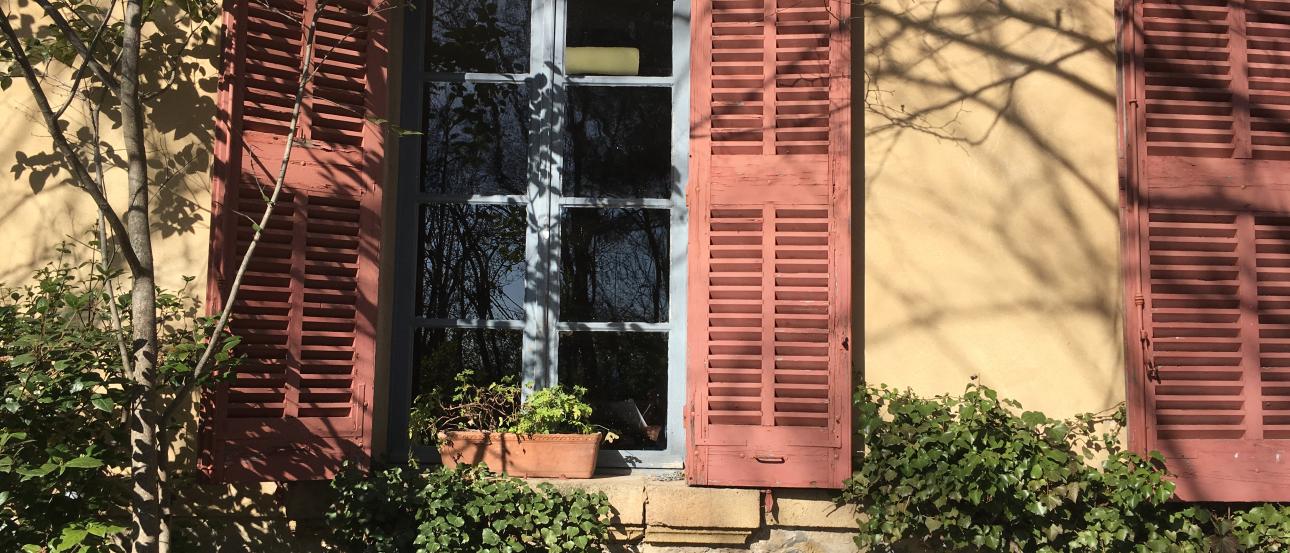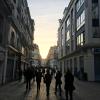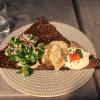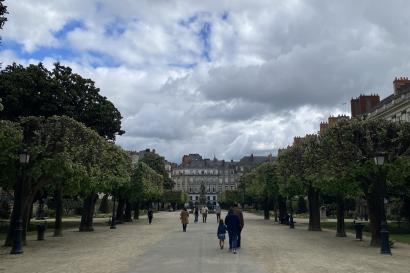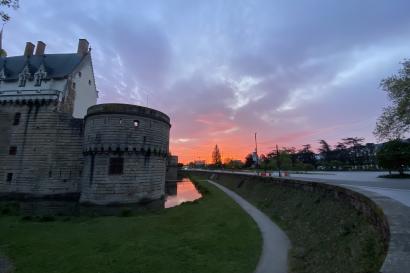A group of four friends and I spent our February break in Aix-en-Provence, a small city in the Provence-Alpes-Côte-d’Azur region of France. Our goal: a relaxing week in a warm place with no formal itinerary. We booked an AirBnB in downtown Aix. Aix’s downtown area is about a kilometer in diameter, encircled by a major road. By the second day, we felt comfortable exploring these streets and got to know the layout pretty well. Our AirBnb, a cute fourth-floor apartment with red walls and white cabinets, provided us a great place to take naps, cook, and watch cult American films in French.
We arrived in Aix late Saturday night, on a high-speed SNCF train from Nantes. I got to write on the train, and we got to watch outside the window as the sun set in magnificent hues of purple, orange, and pink in the French countryside.
Sunday morning (well, it was more like mid-day) we stepped outside to warm sunshine on our faces, vespas whirring past, and the requisite construction nearby. We walked a few blocks and stumbled upon a farmer’s market with fresh fruits, vegetables and goat cheese, of course. We got some sandwiches at a boulangerie, bought fruit from the market, and sat to eat our noshes. Every restaurant here seems to have outside seating options. It’s almost required. Even indoor restaurants have sections of glass walls, glass ceilings, and plants in every corner, so you still feel that you’re outside. Cafés on the main plaza sometimes have up to thirty tables outside, and in the sunny early afternoon there’s often a good chance they’ll be all filled with people!
After our repas (meal), we pursued one of the free museums we’d researched. The Musée de Vieil Aix is a small hole-in-the-wall that includes artifacts from Aix-en-Provence history.
Then, we were intent on finding a local art museum. We took the long way to find it… then as we were walking along one of the larger roads a troop of police motorcycles flew past us. Our minds first jumped to the thought of the gilets jaunes (yellow vest protestors) in Aix, and the police coming in to intervene. But then, we remembered it’s Sunday and the gilets jaunes only come out on Saturdays. Then, we saw a troop of professional cyclists fly past us, at a speed that seemed comparable to the motorcycles. The cyclists wore many different colors and sponsor names. Following them were small cars with bikes propped on the roofs and sponsor names splashed across all sides of the cars. This went on for about twenty minutes-- a troop of cyclists, ten cars, a straggler cyclist, a car, four cyclists, a few cars, and so on. As we kept walking, and as is always the case we ended up back at the center of Aix, we heard a crowd, saw a jumbotron, and the finish line. We learned this event was the Tour de Provence, a preliminary cycling race for professional cyclists which, according to my brother, is a strong indicator for talent in the Tour de France. So cool! We watched for a few minutes from a nearby sidewalk as the winner accepted a medal and various coaches and sponsors spoke. Between the megaphone and the excitement it was a little difficult to understand their French, but the atmosphere of the place was clear.
Tuesday’s excursion was to Marseille, the third largest city in France. It is a Mediterranean city, characterized by its massive port, its yellow/peach/white architecture, and adobe roofing. I also learned that it is the sunniest city in France. It is also an important city for immigration to France and Europe. Tuesday morning we took a 2 € bus from Aix-en-Provence (thank you, tourism office) to Marseille’s major bus and train station downtown. From there, we walked towards the coast, to the Vieux-Port (Old Port) of Marseille. It was teeming with fish salesmen with open ice cases of large freshly-caught fish. There were also many, many yachts and fisherman boats. As we walked along the wooden boardwalks, I saw an older man painting an emerald green coat of paint on the hull of his boat in the bright midday sun. Quaint.
We walked to a nearby park on a small peninsula of the city which abuts Aix-Marseille University, whose buildings were practically ocean-front. What’s not to love? We then walked further south to a small sandy beach so that we could dip our toes into the Mediterranean at least once. As is expected it was cold, but it was still sunny, the sand was warm, and the Azur coast lived up to its name with the beautiful teal of the sea. After shoving our sandy feet back into our sneakers, we trekked up the city (which is really quite hilly) to the Basilique Notre-Dame de la Garde, the most visited site in Marseille that sits upon a limestone outcropping, just south of the old port. We climbed the extensive old stone steps to basilique. The neighborhoods we walked through to get to the steps were also full of narrow streets lined with small shiny cars, light-colored homes, and brightly-colored shutters. The Basilique gave us an incredible view of the city-- from the sea coastline to the miles and miles of neighborhoods that expand north and east of the Marseille’s downtown. We realized just how massive the city was.
Our next agenda item for the day was to find somewhere to eat lunch, although it was at this point 3 p.m. In France, it is characteristic that restaurants are open during lunch hours (probably until about 2 p.m.) and then close until dinner time (around 7 p.m. or often even 8 p.m.). So, ambling around what seemed to be a restaurant district of the city, we were repeatedly turned away by restaurant-owners lounging outside who said they were closed for the afternoon. We ended up going to a boulangerie, although this is never disappointing to have to get another croissant or crêpe.
The afternoon we spent discovering more of the Vieil Port and we ate at an Italien place for dinner. We got on the bus that evening to head back to Aix-en-Provence and one of my friends checked her pedometer to learn that we’d walked 11 miles that day and over 39 floors in elevation.
Friday, our last day in Aix-en-Provence was another exciting day. We went to Cézanne’s (famous impressionist painter) workshop, located in Aix. It was humble and brightly-colored and perfectly situated for the lifestyle of an impressionist painter in the south of France at the end of the 19th century. Cézanne’s house was yellow with red shutters, had a small floor plan, yet three floors. And surrounding the home was ivy everywhere and a massive garden, of course. His workshop was actually just one room on the second floor of his home. His paint smocks, brushes, and palettes looked in almost immaculate condition, like we’d stepped into the workshop in 1906 when they were last touched. The room had tall windows that looked over Aix and high shelves all around the room that kept objects of Cézanne’s painting interest (bottles, vases, jars, fruit, etc). Two of his coats hung in the corner. A letter from Claude Monet to Paul Cézanne in 1895 sat in beautiful script inside a glass case. Azur blue and rusty orange paints remained crusted to wooden palettes in another case.
We left his workshop to walk further up the hill away from Aix’s downtown to see the look-out area where Cézanne painted Mont Sainte-Victoire, a mountain that we hiked the day before. The lookout was situated among houses today and lined with cypress trees, giving a true feeling of existing close to the Mediterranean.
Friday night we enjoyed the last night of a relaxing, exciting week by making ice cream sundaes and watching comedy specials on our Airbnb television. Aix-en-Provence had shown us much-needed sun. We’d tasted calissons, the fruity marzipan dessert speciality of Aix-en-Provence; we’d seen many of Aix’s museums; and we’d dipped our toes in the Mediterranean.
The week had proven thrilling and lovely, but a part of us each wished to head back, to the home we’d now created in Nantes.

Genevieve Winn
<p>I remember creating things from a very young age. What began as duct tape figurines and short stories as a child have transformed into projects of scale today. One of my favorite activities is to sew, but I also love to write. Self-expression through art and writing has always been a strong part of my identity. My hope for the future is to bring my creativity into the world in new ways by creating relationships with people and helping to create solutions to real-world problems. Learning another language is, I think, an important piece to understanding the world a little better, and to knowing how to better serve the people in it. As an IES Correspondent, I hope my writing can help other students to understand study abroad, me, and the beautiful world around us through my daily adventures!</p>
